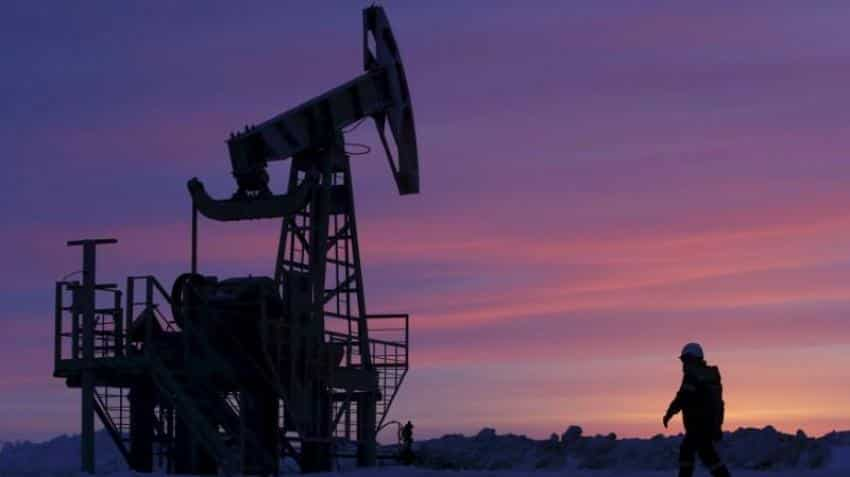Brent crude oil hits highest since November 2014 as Brent edges closer to $80
Even at $80 per barrel, the costs of oil are huge, with Asia’s consumption costing $1 trillion a year, twice as much as during the price lull of 2015/2016.

Oil prices hit their highest level since November 2014 on Thursday, with Brent crude creeping ever closer to $80 per barrel as supplies tightened and demand remained strong. Brent crude futures LCOc1 were at $79.40 per barrel at 0617 GMT, up 0.14 percent from their last close after marking their highest in more than 3-1/2 years.
U.S. West Texas Intermediate (WTI) crude futures were at $71.73 a barrel, up 24 cents, or 0.3 percent, from their last settlement and not far off Tuesday’s $71.92 a barrel - also a level not seen since November 2014.
ANZ bank said on Thursday that Brent was “now threatening to break through $80 per barrel ... (as) geopolitical risks continue to support prices, (and) an unexpected fall in inventories in the U.S. got investors excited.”
U.S. crude inventories C-STK-T-EIA dropped by 1.4 million barrels in the week to May 11, to 432.34 million barrels.
ANZ said the falling U.S. inventories were “raising concerns of tight markets heading into the U.S. driving season,” during which demand typically rises.
U.S. bank Morgan Stanley said it had raised its Brent price forecast to $90 per barrel by 2020 due to a steady increase in demand.
Even at $80 per barrel, the costs of oil are huge, with Asia’s consumption costing $1 trillion a year, twice as much as during the price lull of 2015/2016.
EVERYTHING BULLISH?
Not all indicators pointed to a tighter market, however.
The International Energy Agency (IEA) said on Wednesday it had lowered its global oil demand growth forecast for 2018 from 1.5 million barrels per day (bpd) to 1.4 million bpd.
The IEA said global oil demand would average 99.2 million bpd in 2018, although U.S. bank Goldman Sachs said consumption would cross 100 million bpd “this summer”.
WATCH ZEE BUSINESS VIDEO
And although supplies currently only stand at 98 million bpd due to supply cuts led by the Organization of the Petroleum Exporting Countries (OPEC), the IEA said “strong non-OPEC growth ... will grow by 1.87 million bpd in 2018.”
Leading production increases is the United States, where crude output C-OUT-T-EIA has soared by 27 percent in the last two years, to a record 10.72 million bpd, putting the United States within reach of top producer Russia’s 11 million bpd.
Brokerage Marex Spectron said the surge in U.S. supplies was “strongly price-bearish”, adding the economic outlook was also “firmly bearish” as “short-term credit conditions have worsened which ... hasn’t been priced correctly by the market.”
Goldman Sachs, though, said even with a slowdown in demand and soaring U.S. output, global oil markets would remain tight.
“U.S. shale cannot solve the current oil supply problems,” it said, arguing that U.S. oil would not be sufficient to offset production losses from Iran, Venezuela and Angola.
Goldman also said the tight market left “room for OPEC to exit (its production cuts) without significant price impact.”
Get Latest Business News, Stock Market Updates and Videos; Check your tax outgo through Income Tax Calculator and save money through our Personal Finance coverage. Check Business Breaking News Live on Zee Business Twitter and Facebook. Subscribe on YouTube.
RECOMMENDED STORIES

IPL Auction 2025 Free Live Streaming: When and where to watch Indian Premier League 2025 mega auction live online, on TV, Mobile Apps, and Laptop?

SIP vs PPF: How much corpus you can build in 15 years by investing Rs 1.5 lakh per year? Understand through calculations

SBI Senior Citizen Latest FD Rates: What senior citizens can get on Rs 7 lakh, Rs 14 lakh, and Rs 21 lakh investments in Amrit Vrishti, 1-, 3-, and 5-year fixed deposits
01:23 PM IST








 Rupee appreciates by 8 Paise to 83.49 against Dollar in early trade
Rupee appreciates by 8 Paise to 83.49 against Dollar in early trade Oil prices fall on sticky inflation, bigger-than-expected US crude stock build
Oil prices fall on sticky inflation, bigger-than-expected US crude stock build Oil starts week lower after Israel says 'concluded' Gaza strikes
Oil starts week lower after Israel says 'concluded' Gaza strikes Oil on track to snap losing streak on hopes of further OPEC+ cuts
Oil on track to snap losing streak on hopes of further OPEC+ cuts Apollo Tyres, Kansai Nerolac slip amid rise in crude oil prices; GAIL, Oil India gain
Apollo Tyres, Kansai Nerolac slip amid rise in crude oil prices; GAIL, Oil India gain